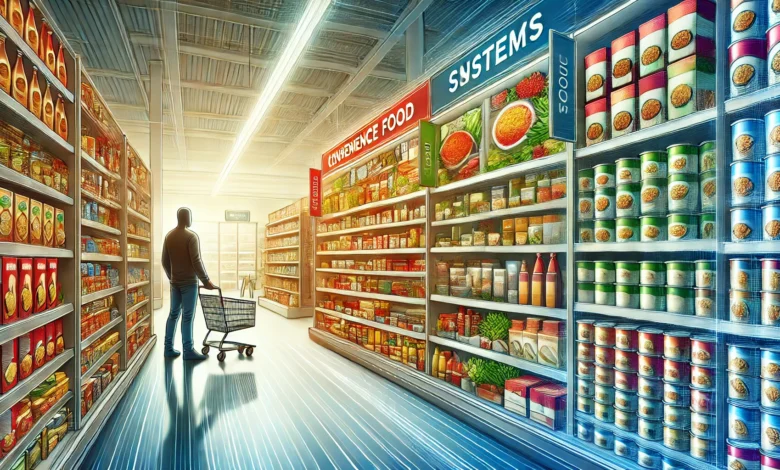Understanding Convenience Food Systems and Their Role in Modern Lifestyles

The rise of convenience food systems has reshaped how people consume meals worldwide. These systems prioritize ready-to-eat, easily accessible food options, catering to busy lifestyles. While they provide undeniable benefits like saving time, they also raise concerns about health, nutrition, and sustainability.
This article explores convenience food systems in detail, examining their structure, impact, and future trends.
What Are Convenience Food Systems?
Convenience food systems refer to the network of production, distribution, and consumption of pre-packaged, ready-to-eat, or easily prepared foods. They are designed to meet the demands of fast-paced modern life, offering solutions for individuals seeking quick and effortless meal options.
These systems include a wide range of foods such as frozen meals, canned goods, snack foods, and even meal kits. Their growing popularity reflects changing consumer preferences and technological advancements in food processing.
The Evolution of Convenience Food Systems
Origins of Convenience Foods
Convenience foods emerged in the early 20th century, initially focusing on canned and frozen goods. These products gained traction during wartime when long-lasting, easily transportable food was essential.
Growth in the Post-War Era
The post-war economic boom in the mid-20th century saw a surge in convenience food consumption. Microwaveable meals and fast-food chains became household staples, catering to the growing number of working families.
Modern Innovations in Convenience Food Systems
Recent years have witnessed a shift toward healthier and more sustainable options, such as organic frozen meals, plant-based snacks, and meal kits with fresh ingredients. Innovations in packaging and food technology continue to expand the possibilities of convenience food systems.
Benefits of Convenience Food Systems
Time-Saving Solutions
Convenience food systems significantly reduce meal preparation time, making them ideal for individuals with busy schedules or limited cooking skills.
Accessibility and Availability
Convenience foods are widely available in grocery stores, vending machines, and online platforms, ensuring accessibility for urban and rural populations alike.
Cost Efficiency
Bulk production and distribution make many convenience foods affordable, catering to diverse income levels.
Diverse Options
The variety within convenience food systems caters to different tastes, dietary needs, and cultural preferences. From gluten-free snacks to ethnic meal kits, there’s something for everyone.
Challenges Associated with Convenience Food Systems
Nutritional Concerns
Many convenience foods are high in sugar, sodium, and unhealthy fats. Over-reliance on these options can lead to health issues such as obesity, hypertension, and diabetes.
Environmental Impact
The production and packaging of convenience foods often contribute to waste and carbon emissions. Single-use plastics and non-biodegradable materials exacerbate environmental challenges.
Cultural Shifts in Eating Habits
Convenience food systems may erode traditional cooking practices, leading to a loss of cultural heritage and communal dining experiences.
Economic Implications
While cost-effective for consumers, convenience food systems can harm small-scale farmers and local food producers who struggle to compete with large corporations.
Trends in Convenience Food Systems
Health-Focused Convenience Foods
Consumers increasingly demand healthier options, prompting brands to create low-calorie, low-sodium, and nutrient-rich alternatives. Examples include pre-cut fruits, salads, and protein-packed snacks.
Sustainable Practices
Sustainability is a growing trend in convenience food systems. Companies are adopting eco-friendly packaging, reducing food waste, and sourcing ingredients from sustainable farms.
Technology-Driven Solutions
Smart vending machines, meal delivery apps, and automated kitchens represent the integration of technology into convenience food systems, further enhancing accessibility and customization.
Plant-Based and Organic Foods
The plant-based food revolution has entered the convenience sector, with products like meat-free burgers, dairy-free desserts, and organic frozen meals becoming mainstream.
How Convenience Food Systems Impact Health
Positive Impacts
- Convenience foods with balanced macronutrients provide a quick and nutritious option for busy individuals.
- Fortified foods address nutritional deficiencies, particularly in populations with limited access to fresh produce.
Negative Impacts
- Overconsumption of highly processed convenience foods can lead to nutrient imbalances and chronic health issues.
- Many convenience foods contain additives and preservatives that may pose long-term health risks.
The Role of Convenience Food Systems in Sustainability
Reducing Food Waste
Pre-portioned meals and frozen foods help minimize food waste by offering controlled servings and extended shelf lives.
Challenges in Packaging
Despite advances in recyclable and biodegradable materials, the packaging used in convenience foods remains a significant environmental challenge.
Support for Local Farmers
Some convenience food brands collaborate with local farmers to source fresh ingredients, supporting the local economy and promoting sustainability.
Tips for Making Healthier Choices in Convenience Food Systems
- Read Labels Carefully
Check for hidden sugars, sodium, and unhealthy fats. Choose products with simple and recognizable ingredients. - Opt for Whole Foods
Select options that prioritize whole grains, lean proteins, and fresh vegetables over processed ingredients. - Limit Portion Sizes
Convenience foods often come in large servings. Be mindful of portion sizes to avoid overeating. - Explore Sustainable Brands
Support companies that prioritize eco-friendly packaging, ethical sourcing, and minimal waste.
Frequently Asked Questions About Convenience Food Systems
What are convenience food systems?
Convenience food systems refer to the network that produces, distributes, and sells ready-to-eat or easily prepared foods designed for quick consumption.
Are convenience foods healthy?
Some convenience foods are healthy, especially those made with whole ingredients and minimal processing. However, many are high in sodium, sugar, and unhealthy fats.
How do convenience foods impact the environment?
The production and packaging of convenience foods contribute to waste and carbon emissions. Choosing eco-friendly brands can help reduce this impact.
Can convenience foods be sustainable?
Yes, many companies are embracing sustainability by using biodegradable packaging, sourcing ingredients locally, and reducing food waste.
What trends are shaping convenience food systems?
Health-focused products, plant-based options, and technology-driven solutions are major trends in the convenience food industry.
Conclusion Understanding the Future of Convenience Food Systems
Convenience food systems have become an integral part of modern lifestyles, offering quick, affordable, and diverse meal options. While they provide undeniable benefits, their impact on health, the environment, and cultural practices must be carefully managed.
By embracing healthier, more sustainable choices, consumers can enjoy the advantages of convenience foods without compromising their well-being or the planet’s future.
